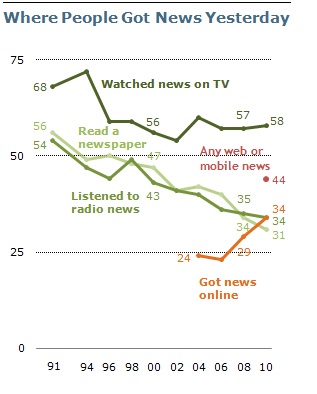 Seventy minutes is the average time an American citizen devotes to the news.
Seventy minutes is the average time an American citizen devotes to the news.
The Web grows, newspapers lose readers, radio and TV remain consistent. In the last 20 years news sources for Americans have changed significantly. According to research conducted by the Pew Research Center, traditional media – radio, TV and newspapers – are on average used by a smaller percentage of people than in the past. If at the beginning of the nineties TV was the primary source of news for 68 percent of people, since the beginning of the 21st century that percentage has decreased to 56 percent and settled.
Radio and newspapers have seen an even greater reduction, with an audience drop of about 20 points overall: radio went from 54 percent to 31 percent, and newspapers from 56 percent to 34 percent. The most significant reduction affected radio and newspapers, while the effect on TV has been more contained.
The principle difference between various forms of traditional media is that the number of TV viewers in the last 10 years stabilized, while for radio and newspapers the negative trend continues to be a constant. A trend that has prompted the likes of Philip Meyer to announce that the last newspaper will be sold in the year 2034, when, it is said prophetically, the print era will end.
Over time, a fourth news dimension has found its place: the Web. Today, according to the study, 34 percent of Americans access and read news on the Internet, a percentage that increases to 44 percent if you also take into consideration the people who access news from any kind of mobile device. These percentages grow continually. Only television, it seems, remains more popular than the Web.
Nevertheless, newspapers have only been able to capture a few among the new wave of readers: in the last four years they’ve lost 6 percent of their audience. In other words, the loss of newspaper readers has not been compensated for by new online readers, a good percentage of whom rely on other news sites.
The advent of a new medium has also modified how people divide the time they devote to getting news – quantified in 70 minutes a day of which 32 are spent in front of the TV, 15 dedicated to radio, 10 to newspaper reading, and 13 to the Web. The most significant fact that seems to emerge from the study is that the total time devoted to hearing/reading news has stayed pretty much the same: it was 74 minutes in 1994 compared to 70 minutes today. However, the 70 minutes are used differently than in the past: the radio and TV component is substantially stable, but newspapers have seen a downturn, and in the average American’s news diet all the minutes taken away from newspapers, TV and radio are now used to access information on the internet.
Another point worth considering is the fact that consumption of news is directly proportionate to age, in other words, older people spend more time getting news than young people do. Those in the 18 – 29 age group spend only 45 minutes getting news, versus 83 minutes spent by those over 65. In particular the study shows that although young people tend to make new technology an integral part of their daily life, they use it very little as a way of getting news and less so than people over 30 do.
Translated by Ann Wise
Tags: American News Consumption, Media research, Media Technology, New media, Pew Research Center, Philip Meyer, Traditional Media, Viewing Habits














































